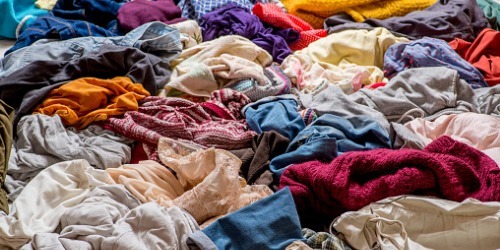The Invisible Threads: Adam Smith and the Global Second-Hand Clothing Trade
August 2, 2023

"Even though some parts of this trade run on American good will (Goodwill pun intended), ultimately the people doing the heavy lifting have to make a profit to keep going. Benevolence alone does not get shirts from Arizona to Ghana."

"Even though some parts of this trade run on American good will (Goodwill pun intended), ultimately the people doing the heavy lifting have to make a profit to keep going. Benevolence alone does not get shirts from Arizona to Ghana."
How does a kid’s pink hoodie end up as an industrial rag cleaning oil valves? The global second-hand trade in clothes connects cultures and economies. Adam Minter in Secondhand: Travels in the New Global Garage Sale vividly describes the characters involved in this thriving industry. This trade intertwines with the principles of Adam Smith. His concept of the “invisible hand” explains how markets connect mall shoppers in New York to dress vendors in Nigeria.
As wealthier individuals seek to refresh their wardrobes, their surplus clothing enters the market for resale. Simultaneously, buyers, often from different countries and backgrounds, are drawn to the affordability of pre-owned garments.
Smith's words echo through time: "It is not from the benevolence of the butcher, the brewer, or the baker that we expect our dinner, but from their regard to their own interest." A secondhand dealer creates value for buyers by being sensitive to market signals. Adam Minter describes how shrewd African and Japanese entrepreneurs select the items that will sell in low-income countries out of the mountains of discarded goods that wealthy consumers shed.
Even though some parts of this trade run on American good will (Goodwill pun intended), ultimately the people doing the heavy lifting have to make a profit to keep going. Benevolence alone does not get shirts from Arizona to Ghana.
Local knowledge is an important element of this process and links to the ideas of the Austrian economist Friedrich Hayek. Minter writes, “The grading warehouses of Cotonou exist because sorters and graders in New Jersey don’t know enough about Nigeria and the tastes of its consumers to sort clothes for them.” Hayek explained that knowledge possessed by individuals is dispersed throughout society. This concept is relevant for understanding patterns in the global second-hand clothing trade.
The reuse and repurposing of garments extend their lifespan, reducing the strain on global resources and minimizing waste. No single individual involved in this trade, from the collectors to the sorters, can know everything about the outcomes that result from the exchanges along the way to the final consumer. Smith's words resonate: "Every individual… neither intends to promote the public interest, nor knows how much he is promoting it... he intends only his own gain, and he is in this... led by an invisible hand to promote an end which was no part of his intention."
Just as it takes many workers to manufacture a new garment from raw materials, it also takes a complex interconnected web of people to send used clothes to the next consumer.
Shoppers for the latest fashion do not need to understand the final destination for their new hoodie. It is not widely known that if donated textiles have no secondhand clothing buyer then they can be profitably turned into industrial wiping rags. Minter describes the transformation of a pink hoodie into several strong soft rags by an expert rag cutter: “Next, she cuts off the zipper and tosses it into a waste bin; she cuts off the sparkly print…” The invisible hand guides the process all the way to the end user who might be working on an oil rig wiping valves.
The occupation of rag picking, as we understand it today, emerged primarily during the 19th century, following the Industrial Revolution. The Industrial Revolution brought about significant changes in society, including the growth of urban centers, the expansion of textile manufacturing, and the rise of mass production. Given that Adam Smith's major works were published in the 18th century, before the height of the Industrial Revolution, he did not write about the occupation of rag picking. New technology and lower shipping costs transformed a formerly low-status occupation into a billion-dollar industry.
The global second-hand clothing trade stands as an embodiment of Adam Smith's economic ideas. Led by the invisible hand these traders connect people and cultures across the world. Value is created by resorting textiles from their first buyers to their final users.
Want to learn more?
From Joy Buchanan: From Pins to Patterns: Following the Threads of Productivity and Taylor Swift's Anti-Hero as a Smithian Anthem
Caren Oberg’s “Who are you wearing?” Fashion production in the age of Adam Smith
Caren Oberg’s John Stuart Mill, Fashion, and Seinfeld's "Bra-less wonder"
EconTalk with Russ Roberts’ Adam Minter on Secondhand
Amy Willis’ EconTalk Extra The Kids Don't Want It
Sarah Skwire’s We Can Rebuild That. We Can Make it Better (a great comparison to Sarah Skwire’s What Would Adam Smith Think of My Weekend?)
From Joy Buchanan: From Pins to Patterns: Following the Threads of Productivity and Taylor Swift's Anti-Hero as a Smithian Anthem
Caren Oberg’s “Who are you wearing?” Fashion production in the age of Adam Smith
Caren Oberg’s John Stuart Mill, Fashion, and Seinfeld's "Bra-less wonder"
EconTalk with Russ Roberts’ Adam Minter on Secondhand
Amy Willis’ EconTalk Extra The Kids Don't Want It
Sarah Skwire’s We Can Rebuild That. We Can Make it Better (a great comparison to Sarah Skwire’s What Would Adam Smith Think of My Weekend?)